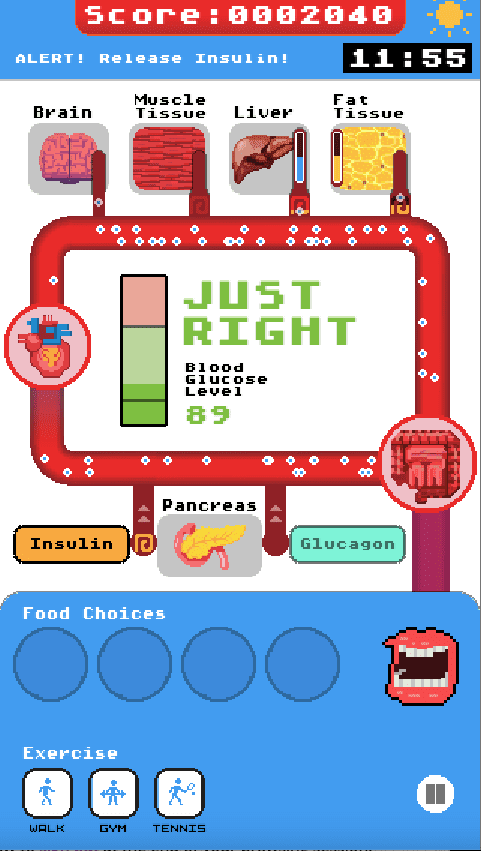Highlights | Interactive health education
- November is National Diabetes Month.
- 38 million Americans live with diabetes.
- A video game created by the Genome Sciences Education Outreach program is helping high school students learn to manage their blood sugar.
Retro-style video games have been around for a while. Pac-Man, Donkey Kong and even Frogger continue to provide hours of pixelated fun. Taking notes from these classics, the UW School of Medicine Department of Genome Science’s UW Genome Sciences Education Outreach group created Blood Sugar Balance, an online game designed for high school students to learn how food choices, lifestyle behaviors and access to health-related resources impact diabetes management
Blood Sugar Balance reminds players of classic video games while turning diabetes education into a fun, interactive experience.
“This game gives students exposure to how our biology mixes with the choices we make. Through different scenarios, they can see how various factors affect how the body processes glucose,” says Atom Lesiak, PhD, director of the Genome Sciences Education Outreach program. “By gamifying science education, we allow students to make decisions and show them the consequences in a model system.”
Lesiak, who uses they/them pronouns, says, the game was so effective the education outreach team received a silver medal for the game’s performance during the International Serious Play Conference in October 2023. This award recognized the game’s creative and engaging approach to teaching health information.
Choose your character

Blood Sugar Balance game preview.
Lesiak says this web-based game helps high school biology students visualize the digestive system and how insulin enters the bloodstream to control glucose levels. With funding from the National Institutes of Health Science Education Partnership Award, Lesiak and curriculum design specialist Joan Griswold connected with graphic design and web development company Blank Space. Together, the company, Lesiak and Griswold, built a platform that lets players see the real-time impact of food and activity choices.
To start, students personalize their player settings. They can choose pre-diabetes, Type 2 diabetes or no diabetes. They also select low, middle or high access to healthcare resources, such as fresh foods, exercise options and medical care — all factors that might affect how a person manages their diabetes in real life. A high game score equals better blood glucose management, and these initial settings help determine their odds of success.
For example, if a player chooses pre-diabetes or Type 2 diabetes, their pancreas or insulin receptors don’t work quite as well. Additionally, players with low resource access have few physical activity options and can only select food found in food deserts. On the other hand, high-access players can work out whenever they want and choose healthier foods.
Reaching the high score
To play, students make food selections. Based on the amount of glucose the food releases into the bloodstream, they select various exercise activities and decide when to release insulin when blood sugar gets too high. They’re encouraged to explore different setting combinations so they can examine how their scores vary based on their life circumstances.
“The game intends to give students a platform to explore different gameplay settings to see how they affect their final score and think about what works well and what doesn’t in diabetes management,” Lesiak says. “In the real world, the perfect circumstances for controlling diabetes don’t exist for everyone. But students learn that they can manage their blood sugar at any level as long as they are aware of what’s happening and how that impacts their food or activity choices.”
Next level diabetes education
Over 2,000 students have played Blood Sugar Balance, Lesiak says. And, just like any other video game, students can choose to play at varying levels of complexity.
At the simplest level, players only monitor how food and activity impact glucose levels. However, the game also builds on several other underlying higher-level concepts. For example, players can observe how blood sugar affects the liver and how it gets turned into fat in the body.
“You can play the game 100 times and never pay attention to how blood sugar affects other organs,” they say. “But we encourage advanced biology teachers to have students work as teams so someone can monitor how blood sugar nourishes or harms the organs. It’s one of the hidden elements of higher learning for students studying biology in an in-depth way.”
Impact on diabetes awareness
More than 38 million Americans live with diabetes. So, Lesiak says, there’s a good chance students know at least one person with the condition, they themselves have it, or they may go on to develop it themselves one day. Lesiak hopes playing Blood Sugar Balance will leave a lasting impact.
In addition to teaching young people how to make healthier lifelong food choices for themselves, Lesiak says playing Blood Sugar Balance can teach them other lessons. With this knowledge, they can coach family members and friends on what it takes to prevent diabetes or minimize the impacts of the condition.
“My hope is we’re making the younger generation more aware of how their decisions impact their health,” they say. “Perhaps when faced with choices, students can reflect on this game and remember that eating candy or drinking sodas all the time isn’t good for them.”
From game to life
Blood Sugar Balance is an entertaining way to learn about diabetes management — but in real life, the game of managing diabetes is more serious, and many people don’t even know they’re playing.
In addition to the millions of Americans living with diabetes, there are 98 million more who have pre-diabetes. And nearly 80% don’t even know it.
In addition to Blood Sugar Balance as a resource, The Centers for Disease Control and Prevention offers an online pre-diabetes risk test and the National Institute of Diabetes and Digestive and Kidney Diseases provides six actions to prevent diabetes health problems.
From game to life, there are options to control diabetes care and management.



